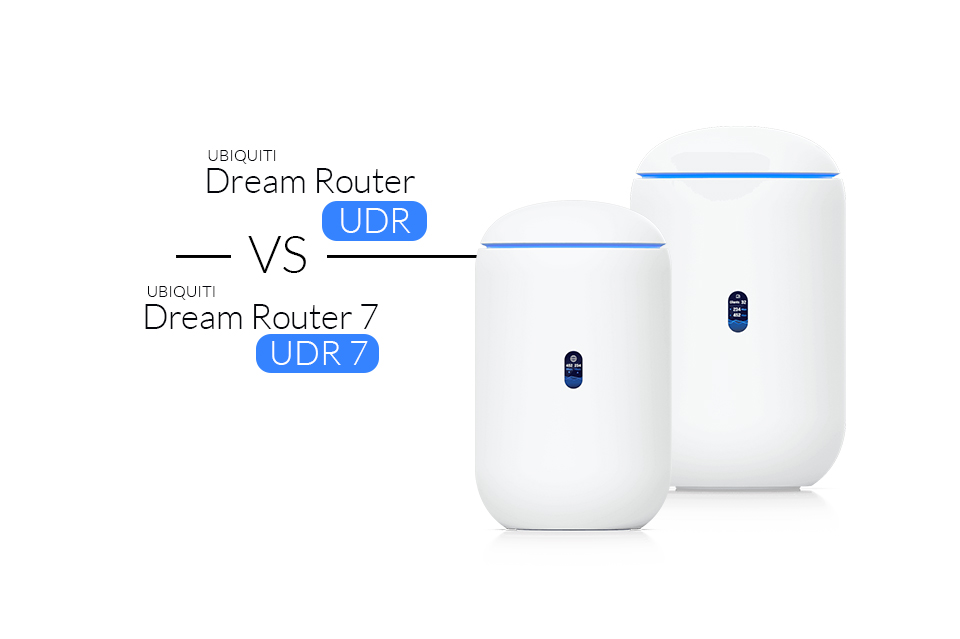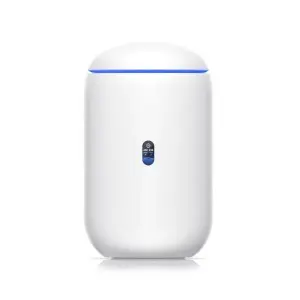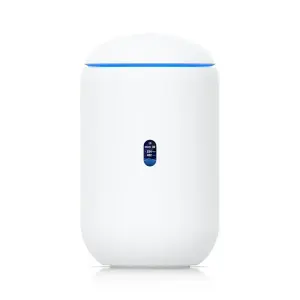
Ubiquiti is the first choice for many network enthusiasts and professionals when it comes to powerful, easy-to-manage network infrastructure. Particularly popular are the UniFi Dream router models, which are ideal for home networks, small offices or tech-savvy power users.
With the classic UniFi Dream Router and the more powerful UDR7, Ubiquiti offers two interesting options. But how do they differ – and which device is right for you?
Overview: What is the UniFi Dream Router?
This product is an all-in-one router with an integrated UniFi Controller that allows you to manage your network centrally – without additional hardware. It is perfect for newcomers to the UniFi world.
Core functions:
- Wi-Fi 6 (2×2 MU-MIMO)
- 5 Gigabit ports (1x WAN, 4x LAN)
- 128 GB internal memory (NAND)
- 2 GB RAM
- 1.7 GHz dual-core CPU
- Integrated UniFi Network Controller
- Support for UniFi Protect (with USB-C or microSD memory expansion)
The UDR is a low-cost, energy-efficient entry into the UniFi ecosystem. It is particularly suitable for households with up to 300 Mbit/s Internet and a manageable number of devices.
What more does the UDR7 offer?
With the Dream Router 7, a more powerful version of the Dream Router, Ubiquiti is targeting users with higher demands.
Improvements compared to the UDR:
- More powerful CPU (quad-core) for more simultaneous processes
- 4 GB RAM (instead of 2 GB)
- Extended internal memory (typically 128-256 GB eMMC or SSD)
- PoE support on some LAN ports (depending on model), ideal for IP cameras and access points
- Better thermals and cooling
- Usually also 1x 2.5G WAN port (depending on model)
These enhancements make the Dream Router 7 a better choice for demanding networks – for example, with many simultaneously connected devices, active use of UniFi Protect (video surveillance), or when additional UniFi components such as access points or switches are to be supplied directly with power.
Comparison: UDR vs. UDR7 in detail
- CPU: Dual-core with 1.7 GHz
- RAM: 2 GB
- Internal memory: 128 GB NAND
- LAN ports: 4x 1 Gbit
- WAN port: 1x 1 Gbit
- Wi-Fi: Wi-Fi 6 (2×2 MIMO)
- PoE support: No
- UI Care: No
- Application area: Small households, beginners, simple networks
- CPU: Modern quad-core processor
- RAM: 4 GB
- Internal memory: 128-256 GB (depending on version, mostly eMMC or SSD)
- LAN ports: 4x 1 Gbit (partly with PoE)
- WAN port: 1x 1 Gbit or 2.5 Gbit (depending on model)
- Wi-Fi: Wi-Fi 6 (2×2 MIMO, better antennas)
- PoE support: Yes (partial)
- UI Care: Yes
- Area of application: Smart homes, video surveillance, larger networks, more demanding users
Which model is suitable for whom?
| User profile | Recommendation |
| Beginner, small household | UDR |
| Home office with moderate traffic | UDR, possibly UDR7 |
| Smart home with many IoT devices | UDR7 |
| Video surveillance with UniFi Protect | UDR7 |
| Networks with multiple access points | UDR7 |
| Future-proof setup with 2.5G WAN | UDR7 |
Accessory recommendations for your UniFi network
Both Dream Routers are a strong core of your network – but the full potential only unfolds with the right accessories. Here are some recommendations for different applications:
Expansion of WLAN coverage
Recommended for: Large apartments, houses with several floors or reinforced concrete ceilings
- UniFi U6-LiteCompact Wi-Fi 6 access point for wall or ceiling mounting – ideal for additional room coverage.
- UniFi U6-LRFor greater range and higher performance, e.g. in detached houses or in the garden.
- UniFi U6-MeshWireless Mesh Access Point – perfect when no LAN cabling is available.
Tip: These access points can be operated directly via the UDR7 (with PoE) or via a PoE injector.
Video surveillance with UniFi Protect
Recommended for: Users who want to integrate surveillance cameras into the home network
- UniFi G4 Instant: Simple, indoor-capable camera with motion detection.
- UniFi G4 Bullet or G5 Bullet: Outdoor-compatible, weatherproof cameras with better image quality.
- Memory expansion (UDR only!): microSD card or SSD via USB-C (min. 128 GB recommended)
Note: The UDR7 usually already has enough internal memory for Protect. With the UDR, you should definitely plan external memory for several cameras.
Network and power supply (PoE)
Recommended for: Setups with multiple access points or cameras
- UniFi Switch Lite 8 PoECompact 8-port switch with 4x PoE outputs – ideal for small installations.
- UniFi Switch 16 PoE: Larger version with more ports and power budget – good for multiple cameras and APs.
UDR7 bonus: Some variants offer PoE directly on the router – so you may not need a separate switch.
Future-proof & speed
Recommended for: Users with Internet connections above 1 Gbit or local NAS infrastructure
- UniFi Switch Flex XG4x 10G SFP+ and 1x 10G RJ45 – for ultra-fast backbone connections.
- UniFi CloudKey G2+ (optional for complex setups): Additional control center for Protect/Network, useful for larger loads.
Our conclusion
The UniFi Dream Router is a great introduction to the world of UniFi – affordable, easy to use and more than enough for many households. However, if you need more power, PoE functionality, and future-proofing, the UniFi Dream Router 7 is the way to go.
Depending on how ambitious your home network or smart home is set up, the extra charge for the 7 version can quickly pay off.



